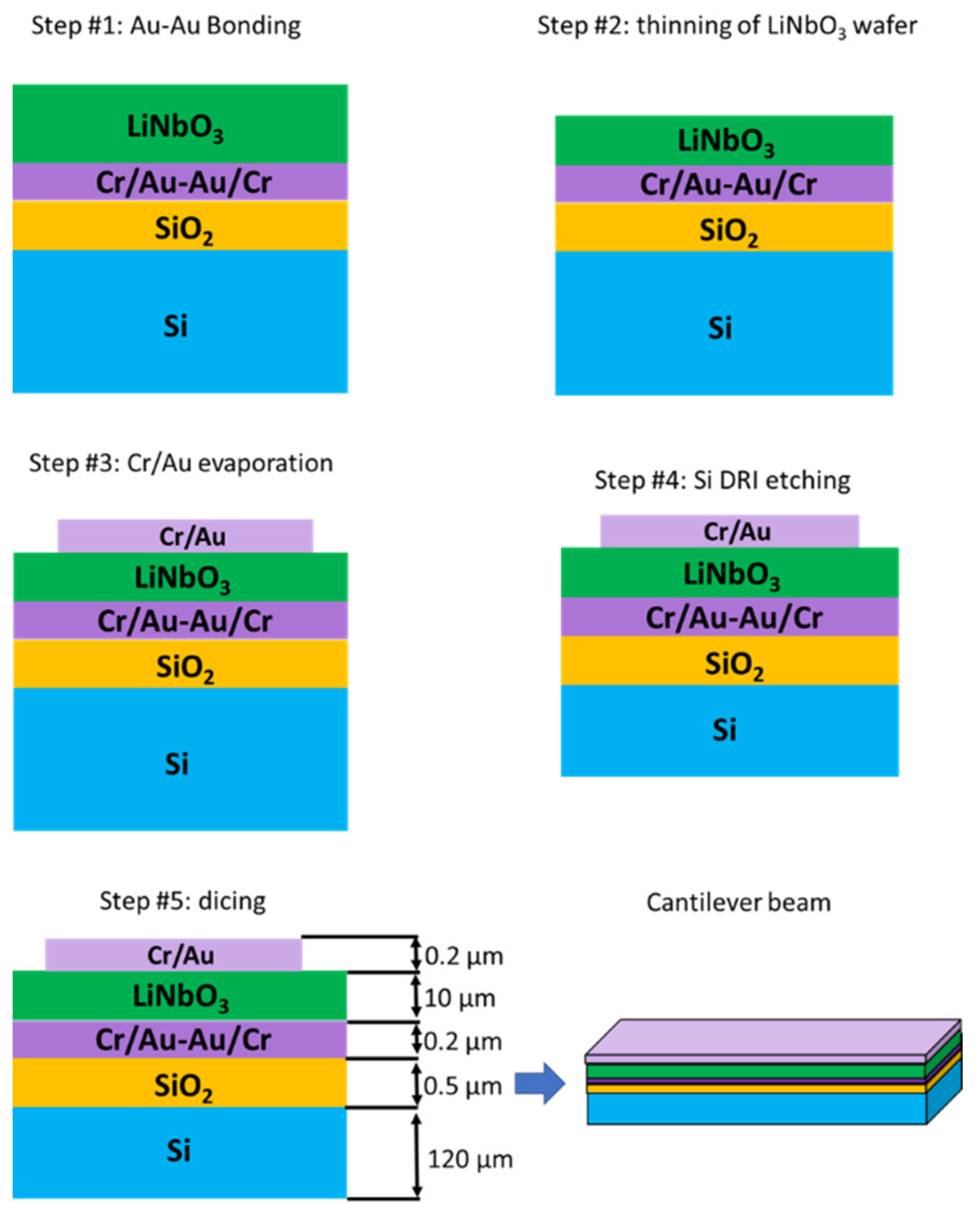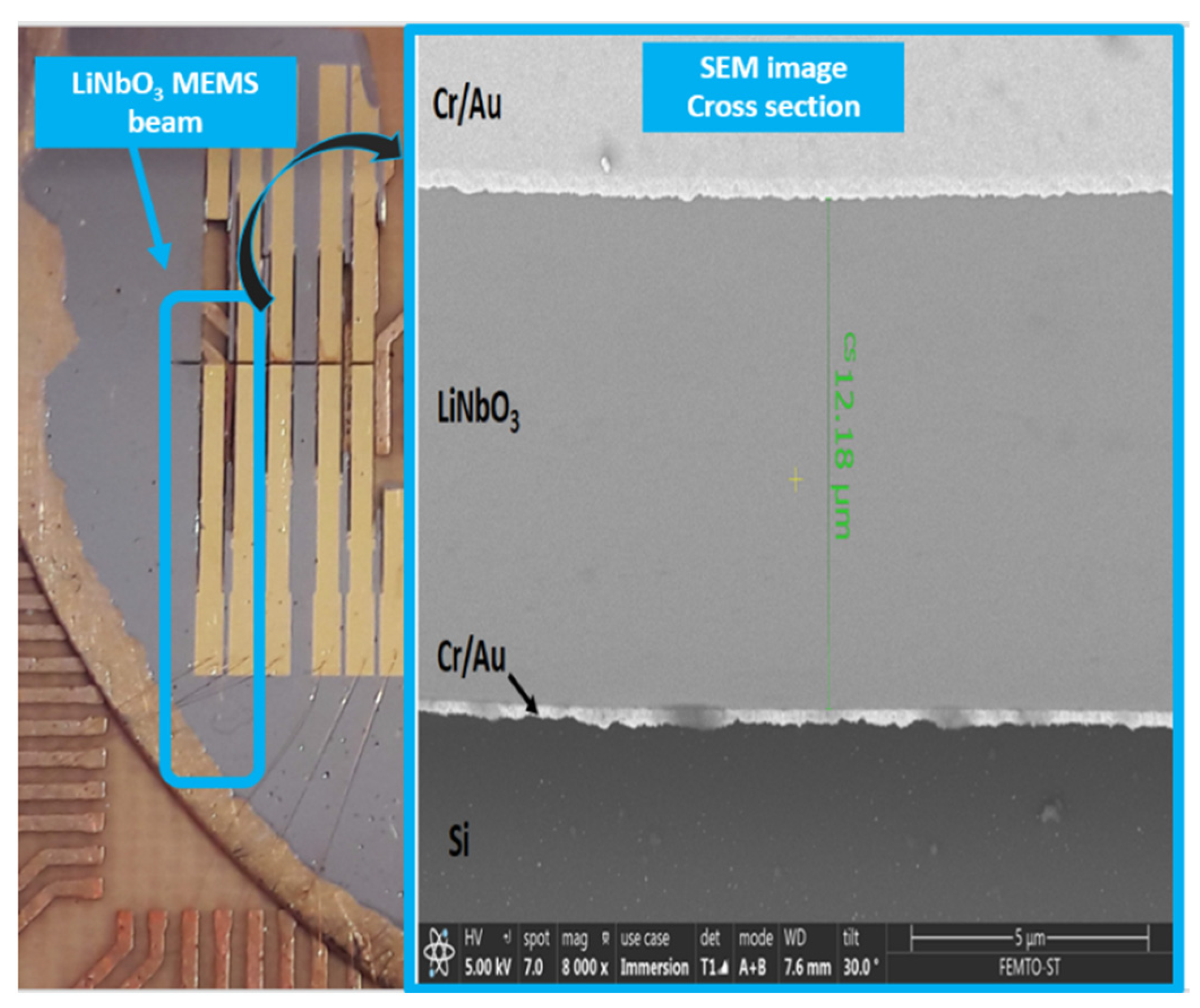Lead-Free LiNbO3 Thick Film MEMS Kinetic Cantilever Beam Sensor/Energy Harvester
Abstract
:1. Introduction
2. Theoretical Considerations
3. Materials and Methods
4. Experimental Results and Discussion
- A signal generator HP33120A, for impressing a suitable waveform to the shaker;
- An oscilloscope, Agilent MSO9064A, for acquiring the signals;
- A single-axis accelerometer used to monitor the imposed vibrations;
- Two laser sensors, used for measuring the sensor displacement (anchor and tip).
5. Conclusions
Author Contributions
Funding
Data Availability Statement
Acknowledgments
Conflicts of Interest
References
- Yang, L.; Ma, Z.; Tian, Y.; Meng, B. Progress on Self-Powered Wearable and Implantable Systems Driven by Nanogenerators. Micromachines 2021, 12, 666. [Google Scholar] [CrossRef]
- Stavropoulos, G.; Papastergiou, A.; Mpaltadoros, L.; Nikolopoulos, S.; Kompatsiaris, I. Iot wearable sensors and devices in elderly care: A literature review. Sensors 2020, 20, 2826. [Google Scholar] [CrossRef] [PubMed]
- Li, R.; Wei, X.; Xu, J.; Chen, J.; Li, B.; Wu, Z.; Wang, Z.L. Smart wearable sensors based on triboelectric nanogenerator for personal healthcare monitoring. Micromachines 2021, 12, 352. [Google Scholar] [CrossRef]
- Varadan, V.K.; Varadan, V.V. Microsensors, microelectromechanical systems (MEMS), and electronics for smart structures and systems. Smart Mater. Struct. 2000, 9, 953. [Google Scholar] [CrossRef]
- Yurish, S.Y. Sensors: Smart vs. intelligent. Sens. Transducers 2010, 114, I–VI. [Google Scholar]
- Ferrari, M.; Ferrari, V.; Guizzetti, M.; Marioli, D.; Taroni, A. Piezoelectric multifrequency energy converter for power harvesting in autonomous microsystems. Sens. Actuators A 2008, 142, 329–335. [Google Scholar] [CrossRef]
- Trigona, C.; Andò, B.; Baglio, S.; La Rosa, R.; Zoppi, G. Sensors for kinetic energy measurement operating on “zero-current standby”. IEEE Trans. Instrum. Meas. 2017, 66, 812–820. [Google Scholar] [CrossRef]
- Doebelin, E.O.; Manik, D.N. Measurement Systems: Application and Design; Tata McGraw Hill Education Private Limited: New Delhi, India, 2007. [Google Scholar]
- Bowen, C.R.; Kim, H.A.; Weaver, P.M.; Dunn, S. Piezoelectric and ferroelectric materials and structures for energy harvesting applications. Energy Environ. Sci. 2014, 7, 25–44. [Google Scholar] [CrossRef] [Green Version]
- Priya, S.; Inman, D.J. Energy Harvesting Technologies; Springer: New York, NY, USA, 2009; Volume 21, p. 2. [Google Scholar]
- Bouhedma, S.; Rao, Y.; Schütz, A.; Yuan, C.; Hu, S.; Lange, F.; Bechtold, T.; Hohlfeld, D. System-level model and simulation of a frequency-tunable vibration energy harvester. Micromachines 2020, 11, 91. [Google Scholar] [CrossRef] [PubMed] [Green Version]
- Xu, Z.; Shan, X.; Yang, H.; Wang, W.; Xie, T. Parametric analysis and experimental verification of a hybrid vibration energy harvester combining piezoelectric and electromagnetic mechanisms. Micromachines 2017, 8, 189. [Google Scholar] [CrossRef]
- Andò, B.; Baglio, S.; Trigona, C.; Dumas, N.; Latorre, L.; Nouet, P. Nonlinear mechanism in MEMS devices for energy harvesting applications. Micromech. Microeng. 2010, 20, 125020. [Google Scholar] [CrossRef] [Green Version]
- Trigona, C.; Dumas, N.; Latorre, L.; Andò, B.; Baglio, S.; Nouet, P. Exploiting benefits of a periodically-forced nonlinear oscillator for energy harvesting from ambient vibrations. Procedia Eng. 2011, 25, 819–822. [Google Scholar] [CrossRef]
- Jean-Mistral, C.; Basrour, S.; Chaillout, J.J. Comparison of electroactive polymers for energy scavenging applications. Smart Mater. Struct. 2010, 19, 085012. [Google Scholar] [CrossRef]
- Brufau-Penella, J.; Puig-Vidal, M.; Giannone, P.; Graziani, S.; Strazzeri, S. Characterization of the harvesting capabilities of an ionic polymer metal composite device. Smart Mater. Struct. 2007, 17, 015009. [Google Scholar] [CrossRef]
- Jeon, Y.B.; Sood, R.; Jeong, J.H.; Kim, S.G. MEMS power generator with transverse mode thin film PZT. Sens. Actuators A 2005, 122, 16–22. [Google Scholar] [CrossRef]
- Lee, B.S.; Lin, S.C.; Wu, W.J.; Wang, X.Y.; Chang, P.Z.; Lee, C.K. Piezoelectric MEMS generators fabricated with an aerosol deposition PZT thin film. J. Micromech. Microeng. 2009, 19, 065014. [Google Scholar] [CrossRef]
- Isarakorn, D.; Briand, D.; Janphuang, P.; Sambri, A.; Gariglio, S.; Triscone, J.M.; Guy, F.; Reiner, J.W.; Ahn, C.H.; De Rooij, N.F. The realization and performance of vibration energy harvesting MEMS devices based on an epitaxial piezoelectric thin film. Smart Mater. Struct. 2011, 20, 025015. [Google Scholar] [CrossRef]
- Muralt, P.; Marzencki, M.; Belgacem, B.; Calame, F.; Basrour, S. Vibration energy harvesting with PZT micro device. Procedia Chem. 2009, 1, 1191–1194. [Google Scholar] [CrossRef] [Green Version]
- Wang, P.; Du, H. ZnO thin film piezoelectric MEMS vibration energy harvesters with two piezoelectric elements for higher output performance. Rev. Sci. Instrum. 2015, 86, 075002. [Google Scholar] [CrossRef]
- Sinatra, V.; Trigona, C.; Andò, B.; Baglio, S. Self-generating Microsensor with Meander Architecture for Performance Enhancement in Inertial Systems. In Proceedings of the 2019 IEEE International Symposium on Measurements & Networking (M&N), Catania, Italy, 8–10 July 2019; pp. 1–5. [Google Scholar]
- Marzencki, M.; Ammar, Y.; Basrour, S. Integrated power harvesting system including a MEMS generator and a power management circuit. Sens. Actuators A 2008, 145–146, 363–370. [Google Scholar] [CrossRef]
- Nakamura, K.; Ando, H.; Shimizu, H. Bending vibrator consisting of a LiNbO3 plate with a ferroelectric inversion layer. Jpn. J. Appl. Phys. 1987, 26, 198–200. [Google Scholar] [CrossRef]
- Le Boulbar, E.D.; Bowen, C.R. Study of Y-cut LiNbO3 (010) Crystal Under oscillated vibration at high temperature for energy harvesting in a hostile environment. In Proceedings of the 2015 Joint IEEE International Symposium on the Applications of Ferroelectric (ISAF), International Symposium on Integrated Functionalities (ISIF), and Piezoelectric Force Microscopy Workshop (PFM), Singapore, 24–27 May 2015; Volume 292. [Google Scholar]
- Clementi, G.; Ouhabaz, M.; Margueron, S.; Suarez, M.A.; Bassignot, F.; Gauthier-Manuel, L.; Dulmet, B.; Bartasyte, A. Highly Coupled and Low Frequency Vibrational Energy Harvester Using Lithium Niobate on Silicon. Appl. Phys. Lett. 2021, 119, 013904. [Google Scholar] [CrossRef]
- Machado, L.Q.; Yurchenko, D.; Wang, J.; Clementi, G.; Margueron, S.; Bartasyte, A. Multi-dimensional constrained energy optimization of a piezoelectric harvester for E-gadgets. iScience 2021, 24, 102749. [Google Scholar] [CrossRef] [PubMed]
- Clementi, G.; Lombardi, G.; Margueron, S.; Suarez, M.A.; Lebrasseur, E.; Ballandras, S.; Imbaud, J.; Lardet-Vieudrin, F.; Gauthier-Manuel, L.; Dulmet, B.; et al. LiNbO3 films—A low-cost alternative lead-free piezoelectric material for vibrational energy harvesters. Mech. Syst. Signal Process. 2021, 149, 107171. [Google Scholar] [CrossRef]
- Panayanthatta, N.; Clementi, G.; Ouhabaz, M.; Costanza, M.; Margueron, S.; Bartasyte, A.; Basrour, S.; Bano, E.; Montes, L.; Dehollain, C.; et al. A Self-Powered and Battery-Free Vibrational Energy to Time Converter for Wireless Vibration Monitoring. Sensors 2021, 21, 7503. [Google Scholar] [CrossRef] [PubMed]
- Lefeuvre, E.; Badel, A.; Richard, C.; Petit, L.; Guyomar, D. A comparison between several vibration-powered piezoelectric generators for standalone systems. Sens. Actuators A 2006, 126, 405–416. [Google Scholar] [CrossRef]
- ANSI/IEEE Std 176-1987; IEEE Standard on Piezoelectricity. IEEE: Piscataway, NJ, USA, 1988.
- Trigona, C.; Sinatra, V.; Crea, G.; Andò, B.; Baglio, S. Characterization of a PiezoMUMPs Microsensor for Contactless Measurements of DC Electrical Current. IEEE Trans. Instrum. Meas. 2020, 69, 1387–1396. [Google Scholar] [CrossRef]
- Guyomar, D.; Badel, A.; Lefeuvre, E.; Richard, C. Toward energy harvesting using active materials and conversion improvement by nonlinear processing. IEEE Trans. Ultrason. Ferroelectr. Freq. Control. 2005, 52, 584–595. [Google Scholar] [CrossRef] [Green Version]
- Erturk, A.; Inman, D.J. Issues in mathematical modeling of piezoelectric energy harvesters. Smart Mater. Struct. 2008, 17, 065016. [Google Scholar] [CrossRef] [Green Version]








| C0 (pF) | M (mg) | C (N·s·m−1) | K (N·m−1) | α (N·V−1) | XM (µm) |
|---|---|---|---|---|---|
| 744 | 1.133 | 9.948 × 10−5 | 731.4 | 4.7619 × 10−5 | 0.98 |
| Material | Frequency (Hz) | Vrms (mV) | Power (nW) |
|---|---|---|---|
| (YXlt)/163°/90° LiNbO3 | 4092 | 37 | 3 |
| PZT-5A | 3536 | 33 | 2 |
Publisher’s Note: MDPI stays neutral with regard to jurisdictional claims in published maps and institutional affiliations. |
© 2022 by the authors. Licensee MDPI, Basel, Switzerland. This article is an open access article distributed under the terms and conditions of the Creative Commons Attribution (CC BY) license (https://creativecommons.org/licenses/by/4.0/).
Share and Cite
Barrientos, G.; Clementi, G.; Trigona, C.; Ouhabaz, M.; Gauthier-Manuel, L.; Belharet, D.; Margueron, S.; Bartasyte, A.; Malandrino, G.; Baglio, S. Lead-Free LiNbO3 Thick Film MEMS Kinetic Cantilever Beam Sensor/Energy Harvester. Sensors 2022, 22, 559. https://doi.org/10.3390/s22020559
Barrientos G, Clementi G, Trigona C, Ouhabaz M, Gauthier-Manuel L, Belharet D, Margueron S, Bartasyte A, Malandrino G, Baglio S. Lead-Free LiNbO3 Thick Film MEMS Kinetic Cantilever Beam Sensor/Energy Harvester. Sensors. 2022; 22(2):559. https://doi.org/10.3390/s22020559
Chicago/Turabian StyleBarrientos, Gabriel, Giacomo Clementi, Carlo Trigona, Merieme Ouhabaz, Ludovic Gauthier-Manuel, Djaffar Belharet, Samuel Margueron, Ausrine Bartasyte, Graziella Malandrino, and Salvatore Baglio. 2022. "Lead-Free LiNbO3 Thick Film MEMS Kinetic Cantilever Beam Sensor/Energy Harvester" Sensors 22, no. 2: 559. https://doi.org/10.3390/s22020559
APA StyleBarrientos, G., Clementi, G., Trigona, C., Ouhabaz, M., Gauthier-Manuel, L., Belharet, D., Margueron, S., Bartasyte, A., Malandrino, G., & Baglio, S. (2022). Lead-Free LiNbO3 Thick Film MEMS Kinetic Cantilever Beam Sensor/Energy Harvester. Sensors, 22(2), 559. https://doi.org/10.3390/s22020559








